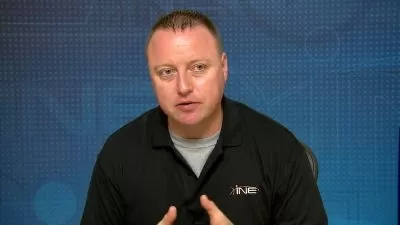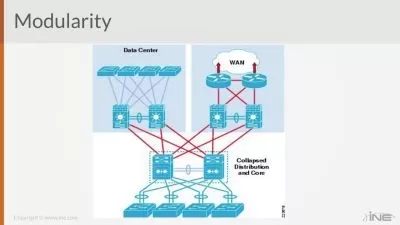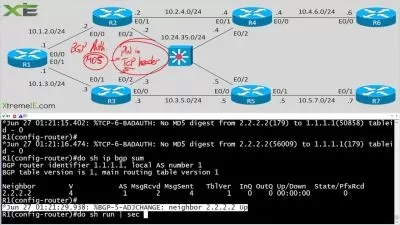CCNP and CCIE Enterprise Core ENCOR 350-401
Focused View
29:52:40
85 View
01-Learning Objectives.mp4
00:21
02-1.1 Packet Forwarding Overview.mp4
02:20
03-1.2 Layer 2 Forwarding Essentials.mp4
02:47
04-1.3 Layer 3 Forwarding.mp4
05:06
05-2.1 VLANS.mp4
03:34
06-2.2 Switch Port Types.mp4
10:53
07-2.3 VLAN Trunking Protocol (VTP).mp4
07:58
08-2.4 Dynamic Trunking Protocol (DTP).mp4
03:16
09-Learning Objectives.mp4
00:32
10-3.1 Introducting the Spanning Tree Protocol (STP).mp4
06:55
11-3.2 Building STP Topology.mp4
06:35
12-3.3 Per VLAN Spanning Tree (PVST) and PVST+.mp4
06:11
13-3.4 STP Convergence.mp4
08:38
14-3.5 Rapid Spanning Tree Protocol (RSTP).mp4
04:06
15-3.6 Tuning the STP Topology.mp4
09:50
16-3.7 Optimizing the Spanning Tree Topology.mp4
09:35
17-3.8 Multiple Spanning Tree Protocol (MSTP).mp4
05:26
18-Learning Objectives.mp4
00:32
19-4.1 Introducing EtherChannel Bundles.mp4
02:45
20-4.2 Static EtherChannel.mp4
03:47
21-4.3 Port Aggregation Protocol (PAgP).mp4
05:07
22-4.4 Link Aggregation Control Protocol (LACP).mp4
11:49
23-4.5 Layer 3 EtherChannel Bundles.mp4
03:04
24-4.6 Troubleshooting EtherChannel Bundles.mp4
01:39
25-Learning Objectives.mp4
00:23
26-5.1 Routing Protocol Overview.mp4
07:29
27-5.2 Path Selection.mp4
05:00
28-5.3 Platform Architecture.mp4
03:32
29-5.4 Virtual Routing and Forwarding (VRF).mp4
06:02
30-Learning Objectives.mp4
00:31
31-6.1 Introducing Open Shortest Path First (OSPF).mp4
10:42
32-6.3 Timers and Failure Dectection.mp4
04:13
33-6.4 Designated Router and Backup Designated Router.mp4
09:46
34-6.5 OSPF Network Types.mp4
07:41
35-6.6 Areas.mp4
10:59
36-6.7 Default Route Advertisement.mp4
03:44
37-6.8 Link State Advertisements (LSA).mp4
08:06
38-6.9 OSPF Path Selection.mp4
07:01
39-Learning Objectives.mp4
00:26
40-7.1 Introducing Open Shortest Path First Version 3 (OSPFv3).mp4
03:42
41-7.2 OSPFv3 Configuration and Verification.mp4
23:19
42-Learning Objectives.mp4
00:40
43-8.1 Introducing Border Gateway Protocol (BGP).mp4
06:20
44-8.2 Communication.mp4
08:22
45-8.3 Session Configuration.mp4
14:24
46-8.4 Prefix Advertisement.mp4
19:30
47-8.5 Route Summarizatoin.mp4
09:41
48-8.6 BGP Communities.mp4
03:16
49-8.7 BGP Multihoming.mp4
04:13
50-8.8 Best Path.mp4
15:49
51-8.9 Multiprotocol BGP for IPv6.mp4
22:43
52-Learning Objectives.mp4
00:26
53-9.2 Route Maps.mp4
05:45
54-9.3 OSPF Filtering.mp4
08:12
55-9.4 BGP Route Filtering.mp4
07:44
56-Learning Objectives.mp4
00:43
57-10.1 Multicast Fundamentals.mp4
06:27
58-10.2 Multicast Addressing (L2 and L3 Addressing).mp4
06:30
59-10.3 Internet Group Management Protocol (IGMP).mp4
12:19
60-10.4 Protocol Independent Multicast (PIM).mp4
08:24
61-10.5 Rendezvous Points (RP).mp4
07:36
62-10.6 Multicast Packet Flow.mp4
04:52
63-10.7 Configuring and Verifying Multicast.mp4
21:57
64-Learning Objectives.mp4
00:34
65-11.1 The Need for Quality of Service (QoS).mp4
07:19
66-11.2 QoS Models.mp4
09:24
67-11.3 Classification and Marking.mp4
13:54
68-11.4 Policing and Shaping.mp4
21:40
69-11.5 Congestion Management and Avoidance.mp4
12:18
70-Learning Objectives.mp4
01:12
71-12.1 Network Time Protocol (NTP) Overview.mp4
10:52
72-12.2 Configuring and Verifying NTP.mp4
08:21
73-12.3 Hot Standby Router Protocol (HSRP) Overview.mp4
23:59
74-12.4 Virtual Router Redundancy Protocol (VRRP).mp4
10:43
75-12.5 Global Load Balancing Protocol (GLBP).mp4
15:10
76-Learning Objectives.mp4
00:30
77-13.1 Introducing Network Address Translation (NAT).mp4
05:55
78-13.2 Static NAT.mp4
16:54
79-13.3 Pooled NAT.mp4
07:49
80-13.4 Port Address Translation (PAT).mp4
05:43
81-Learning Objectives.mp4
01:03
82-14.1 Network Security Design for Threat Defence.mp4
08:51
83-14.2 Next Generation Endpoint Security.mp4
06:42
84-14.3 Cisco Stealthwatch.mp4
05:28
85-14.4 Cisco ISE.mp4
04:11
86-14.5 802.1x.mp4
11:05
87-14.6 MAB.mp4
03:11
88-14.7 Cisco TrustSec.mp4
09:16
89-14.8 MACSec.mp4
04:14
90-Learning Objectives.mp4
01:06
91-15.1 ACLs.mp4
04:29
92-15.2 Configuring and Verifying ACLs.mp4
19:07
93-15.3 Terminal Lines and Password Protection.mp4
19:08
94-15.4 AAA.mp4
18:37
95-15.5 ZBFW.mp4
14:31
96-15.6 Control Plane Policing (CoPP).mp4
11:37
97-Learning Objectives.mp4
01:10
98-16.1 Introducing Cisco Wireless.mp4
01:23
99-16.2 Layer 1 Concepts.mp4
28:43
100-16.3 RF Power.mp4
04:16
101-16.4 RSSI.mp4
03:18
102-16.5 Interference Noise.mp4
20:46
103-16.6 SNR.mp4
04:26
104-16.7 Band and Channels.mp4
11:53
105-16.8 Wireless Devices Capabilities.mp4
21:48
106-16.9 AP Modes and Antenna Types.mp4
25:51
107-16.10 Wireless LAN TopologiesStandalone.mp4
15:26
108-16.11 Wireless LAN TopologiesCentralized Mode.mp4
16:41
109-16.12 Wireless LAN TopologiesFlexConnect Mode.mp4
09:39
110-16.13 Wireless LAN TopologiesEWC Mobility Express, IP Addressing, Mesh, Auto-Anchor.mp4
19:07
111-16.14 Access Point Discovery and Join Process.mp4
07:26
112-16.15 Main Principles and Use Cases for Layer 2 and Layer 3 Roaming.mp4
26:42
113-16.16 Configuring Wireless.mp4
26:19
114-16.17 Troubleshoot WLAN Configuration and Wireless Client Connectivity Issues.mp4
26:34
115-16.18 Wireless Security General Considerations.mp4
16:55
116-16.19 Configuring the Wireless Controller, Open Authentication, WPA2 PSK Authentication.mp4
21:55
117-16.20 Configuring Local EAP Authentication, External EAP Authentication, Web-Auth Authentication.mp4
17:40
118-Learning objectives.mp4
00:35
119-17.1 Generic Routing Encapsulation (GRE) Overview.mp4
02:06
120-17.2 Configuring and Verifying GRE Tunnels.mp4
07:21
121-17.3 IPSec Fundamentals.mp4
06:40
122-17.4 Site-to-Site IPSec VPN Overview.mp4
03:22
123-17.5 Configuring and Verifying Site-to-Site IPSec VPN.mp4
10:28
124-17.6 LISP Fundamentals.mp4
22:40
125-17.7 VXLAN Fundamentals.mp4
08:07
126-17.8 VXLAN-EVPN Overview.mp4
07:41
127-18.1 Introducting Cisco Software-Defined Access Solution.mp4
13:18
128-18.2 Cisco Software-Defined Access Control.mp4
15:15
129-18.3 Cisco Software-Defined Access Data Planes.mp4
13:27
130-18.4 Fabric Roles and Terminology.mp4
20:41
131-18.5 Inserting Fabric Into a Traditional Campus Network.mp4
11:01
132-18.6 Fabric Wireless and L2 Domain Stretch.mp4
09:29
133-18.7 DNA Center Demo (Design and Policy).mp4
11:16
134-18.8 DNA Center Demo (DNA Center Assurance).mp4
23:13
135-Learning objectives.mp4
00:55
136-19.1 Introducing Cisco SD-WAN Solution.mp4
01:01
137-19.2 Value Proposition & Cisco SD-WAN Benefits.mp4
16:17
138-19.3 Value Proposition and Cisco SD-WAN Use Cases.mp4
12:26
139-19.4 Cisco SD-WAN Architecture.mp4
12:41
140-19.5 Cisco SD-WAN Solution Concepts - Orchestration Plane.mp4
07:04
141-19.6 Cisco SD-WAN Solution Concepts - Control Plane.mp4
04:56
142-19.7 Cisco SD-WAN Solution Concepts - Data Plane.mp4
05:21
143-19.8 Cisco SD-WAN Solution Concepts - Management Plane.mp4
03:43
144-19.9 Cisco SD-WAN Protocols, Topologies and Important Concepts.mp4
20:42
145-19.10 Transport Features.mp4
09:31
146-19.11 Data Plane Features.mp4
12:54
147-19.12 Device and Application Automation.mp4
11:12
148-19.13 Using Cisco SD-WAN With Traditional WAN Networking.mp4
12:30
149-19.14 vManage Demo.mp4
21:33
150-Learning objectives.mp4
00:36
151-20.1 Server Virtualization.mp4
08:41
152-20.2 Network Function Virtualization (NFV).mp4
07:07
153-20.3 Enterprise Network Function Virtualization (ENFV).mp4
06:28
154-Learning objectives.mp4
01:07
155-21.1 Diagnose Network Problems Using Tools Such as Debugs, Conditional Debugs,Traceroute, Ping, SNMP and Syslog.mp4
01:17
156-21.2 Ping and Traceroute Commands.mp4
19:40
157-21.3 Debug Commands.mp4
23:08
158-21.4 Conditional Debug Commands.mp4
10:57
159-21.5 SNMP Commands.mp4
49:16
160-21.6 Syslog Commands.mp4
03:37
161-21.7 Configure and Verify Device Monitoring Using Syslog for Remote Logging.mp4
04:56
162-21.8 Configure and Verify NetFlow and Flexible NetFlow.mp4
10:39
163-21.9 Configure and Verify SPAN RSPAN.mp4
09:25
164-21.10 Configure and Verify ERSPAN.mp4
10:58
165-21.11 Exploring the Dashboard and Design.mp4
15:37
166-21.12 Exploring Assurance Network Health.mp4
04:46
167-21.13 Exploring Assurance Client Health.mp4
08:54
168-21.14 Configure and Verify IP SLA.mp4
13:10
169-Learning objectives.mp4
01:54
170-22.1 API.mp4
04:47
171-22.2 Tools and Resources.mp4
06:27
172-22.3 Data Formats.mp4
09:18
173-22.4 Cisco DNA Center APIs.mp4
04:15
174-22.5 Cisco vManage APIs.mp4
04:02
175-22.6 Data Models and Supporting Protocols.mp4
19:51
176-22.7 Cisco DevNet.mp4
06:29
177-22.8 GitHub.mp4
05:13
178-22.9 Introduction to Python.mp4
06:06
179-22.10 Python Variables and Data Types.mp4
12:21
180-22.11 Python Data Structures.mp4
13:02
181-22.12 Writing Python Program Using Loops and Functions.mp4
15:36
182-22.13 Dealing With JSON Data in Python.mp4
10:33
183-22.14 Enabling NETCONF and RESTCONF on Cisco IOS-XE.mp4
01:42
184-Learning objectives.mp4
00:58
185-23.1 EEM.mp4
22:41
186-23.2 Configuring EEM.mp4
05:38
187-23.3 Puppet.mp4
05:38
188-23.4 Chef.mp4
05:31
189-23.5 SaltStack.mp4
06:47
More details
User Reviews
Rating
average 0
Focused display
Category

LiveLessons
View courses LiveLessonsPearson's video training library is an indispensable learning tool for today's competitive job market. Having essential technology training and certifications can open doors for career advancement and life enrichment. We take learning personally. We've published hundreds of up-to-date videos on wide variety of key topics for Professionals and IT Certification candidates. Now you can learn from renowned industry experts from anywhere in the world, without leaving home.
- language english
- Training sessions 189
- duration 29:52:40
- Release Date 2023/11/07










